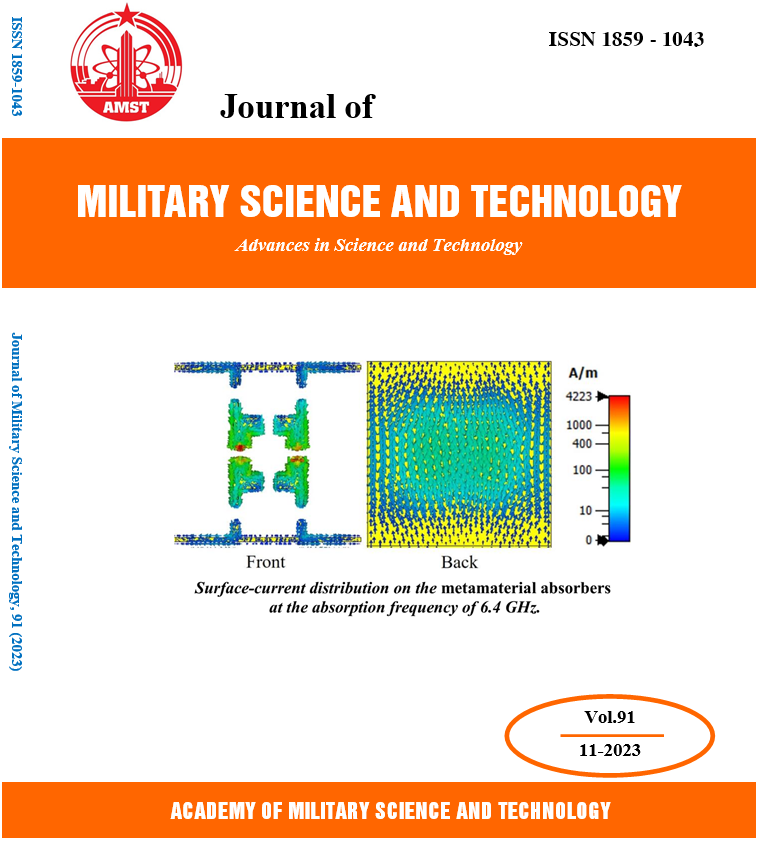Prediction of Air Quality Index using genetic programming
368 viewsDOI:
https://doi.org/10.54939/1859-1043.j.mst.91.2023.85-95Keywords:
Machine Learning; Genetic Programming; AQI.Abstract
The Air Quality Index (AQI) is a tool used to measure the impact of air pollution on health over time. In the world, air pollution has significantly increased, and machine learning techniques are used to forecast and analyze AQI. We present a new way for using GP to evolve models for AQI forecasting in this work GP can evolve more accurate AQI forecasting models than other standard machine learning algorithms, according to experimental results using datasets obtained from various stations across multiple cities in India. Furthermore, while developing AQI forecasting models, GP can automatically identify significant features, and the models developed by GP are interpretable.
References
[1]. E. E. A. (EEA), “Air Quality in Europe 2022 Report,” Publications Office, https://doi.org/10.2800/488115. ISBN: 978-92-9480-515-7, (2022).
[2]. J. v. d. H. D. Z. P. v. R. S. Duyzer, “Representativeness of air quality monitoring networks,” Atmos. Environ., vol. 104, p. 88–101, (2015). DOI: https://doi.org/10.1016/j.atmosenv.2014.12.067
[3]. G. M. A. M. W. P. E. &. A. E. Raimondo, “A machine learning tool to forecast PM10 level,” in AMS 87th Annual Meeting, San Antonio, TX, USA, (2007).
[4]. G. Raimondo, A. Montuori, W. Moniaci, E. Pasero and E. Almkvist, “A Machine Learning Tool to Forecast PM10 Level,” in The Fifth Conference on Artificial Intelligence Applications to Environmental Science, San Antonio, TX, USA, (2007).
[5]. R. Y. Y. Y. L. H. G. &. M. O. A. Yu, “RAQ–A random forest approach for predicting air quality in urban sensing systems,” Sensors, vol. 16, no. 86, (2016). DOI: https://doi.org/10.3390/s16010086
[6]. K. &. D. A. Veljanovska, “Air quality index prediction using simple machine learning algorithms,” International Journal of Emerging Trends & Technology in Computer Science (IJETTCS), vol. 7, no. 1, pp. 25-30, (2018).
[7]. H. Q. L. D. Y. a. Y. G. Liu, “Air quality index and air pollutant concentration prediction based on machine learning algorithms,” Applied Sciences, vol. 9, p. 4069, (2019). DOI: https://doi.org/10.3390/app9194069
[8]. K. S. V. B. H. K. S. R. A. Hu, “Svr based dense air pollution estimation model using static and wireless sensor network,” IEEE SENSORS, pp. 1-3, (2016).
[9]. A. Chelani, “Prediction of daily maximum ground ozone concentration using support vector machine,” Environmental monitoring and assessment, vol. 162, pp. 169-176, 2009. DOI: https://doi.org/10.1007/s10661-009-0785-0
[10]. S. M. S. S. S. Kumar, “A machine learning-based model to estimate pm2.5 concentration levels in Delhi’s atmosphere,” Heliyon 6, vol. 11, (2020). DOI: https://doi.org/10.1016/j.heliyon.2020.e05618
[11]. M. C. C. N. X. B. B. T. S. Zamani Joharestani, “PM2.5 prediction based on random forest, xgboost, and deep learning using multisource remote sensing data,” Atmosphere, vol. 10, no. 7, p. 373, (2019). DOI: https://doi.org/10.3390/atmos10070373
[12]. J. L. Y. M. W. Z. X. W. X. B. F. Z. Y. W. Z. L. H. Zhan, “Ozone formation sensitivity study using machine learning coupled with the reactivity of volatile organic compound species,” Atmospheric Measurement Techniques, vol. 15, no. 5, pp. 1511-1530, (2022). DOI: https://doi.org/10.5194/amt-15-1511-2022
[13]. Z. C. B. H. Y. D. L. Y. T. Song, “Estimation of pm2.5 concentration in China using linear hybrid machine learning model,” Atmospheric Measurement Techniques, vol. 14, no. 8, p. 5333–5347, (2021). DOI: https://doi.org/10.5194/amt-14-5333-2021
[14]. A. B. B. G. D. B. A. S. E. S. J. K. K. Analitis, “Prediction of pm2.5 concentrations at the locations of monitoring sites measuring pm10 and nox, using generalized additive models and machine learning methods: a case study in london,” Atmospheric Environment, vol. 240, (2020). DOI: https://doi.org/10.1016/j.atmosenv.2020.117757
[15]. Z. Y. S.-L. H. K.-F. Li, “High temporal resolution prediction of street-level pm2.5 and nox concentrations using machine learning approach,” Journal of Cleaner Production, vol. 268, (2020). DOI: https://doi.org/10.1016/j.jclepro.2020.121975
[16]. P.-Y. H. C.-Y. W. J.-Y. T. T.-A. H. J.-W. G. H.-R. S. H.-J. W. C.-. D. S. J. Wong, “Incorporating land-use regression into machine learning algorithms in estimating the spatial-temporal variation of carbon monoxide in taiwan,” Environmental Modelling Software, vol. 139, (2021). DOI: https://doi.org/10.1016/j.envsoft.2021.104996
[17]. Y. L. Y. D. X. Z. K. Z. M. G. M. d. B. Zhan, “Satellitebased estimates of daily no2 exposure in China using hybrid random forest and spatiotemporal kriging model,” Environmental Science Technology, vol. 52, no. 3, (2019).
[18]. P. B. X. T. K. X. Z. S. A. X. J. L. E. S. H. L. W. Du, “Advances of four machine learning methods for spatial data handling: a review,” Journal of Geovisualization and Spatial Analysis, vol. 4, pp. 1-25, (2020). DOI: https://doi.org/10.1007/s41651-020-00048-5
[19]. M. H. V. Y. H. &. Y. S. Filonchyk, “Atmospheric pollution assessment near potential source of natural aerosols in the South Gobi Desert region, China,” GIScience & Remote Sensing, vol. 57, no. 2, pp. 227-244, (2020).
[20]. A. D. S. &. D. A. K. Kumar, “Comparative evaluation of fitness of interpolation techniques of ArcGIS using leave-one-out scheme for air quality mapping,” Journal of Geovisualization and Spatial Analysis, vol. 6, no. 1, p. 9, (2022). DOI: https://doi.org/10.1007/s41651-022-00102-4
[21]. J. Koza, Genetic Programming: On the Programming of Computers by Means of Natural Selection, MIT Press, (1992).
[22]. L. P. G. B. S. P. Z. S. J. B. R. H. a. A. C. S. Luke, “Ecj: A java-based evolutionary computation research system,” (2007).
[23]. M. H. V. Y. H. &. Y. S. Filonchyk, “Atmospheric pollution assessment near potential source of natural aerosols in the South Gobi Desert region, China,” GIScience & Remote Sensing, vol. 57, no. 2, pp. 227-244, (2020). DOI: https://doi.org/10.1080/15481603.2020.1715591







